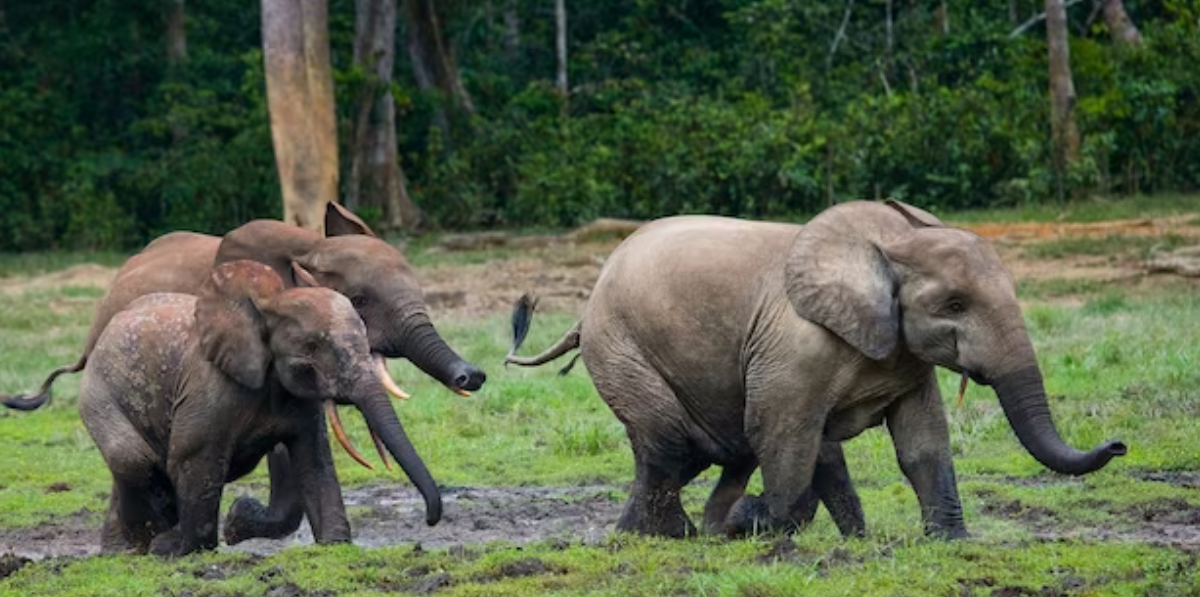
Intriguing facts about African Elephants
An amazing animal belonging to the African continent is the African elephant. Males may grow up to 13 feet tall and weigh up to 14,000 pounds, making them the biggest terrestrial mammal on Earth. Known for their very lengthy trunks, these magnificent creatures utilise them for breathing, drinking, and grasping items, among other functions. Their long ears let them communicate with other elephants over great distances, in addition to helping them stay cool in the hot African environment.
Behaviour and Social Structure of African elephants
Living in close-knit family groupings known as herds, African elephants are gregarious creatures. Typically, the matriarch—the oldest and most seasoned female in the group—leads these herds. The matriarch is essential to the herd because she leads the group to water and food sources and shields the younger animals from harm. These sentient animals have an intricate system of communication that includes a variety of vocalisations, body language, and even infrasound, a low-frequency sound that has a great range of propagation.
African elephants have unique features and Feeding Habits
African elephants have an amazing memory, which is one of their most remarkable features. Even after several years, it has been shown that they can still recall the locations of food and water supplies. In the wide African savannah, where supplies might be limited, their extraordinary recall aids in their survival. Because they are herbivores, African elephants mostly eat grass, leaves, bark, and fruits. They eat up to three hundred pounds of food a day, which takes a long time to feed. Owing to their size and voracious appetite, they create clearings and spread seeds via their excrement, which significantly influences the habitats they live in.
Interesting facts about African elephants
Global public interest in African elephants has been sparked by these magnificent animals. Being the biggest land mammals on Earth, these gentle giants are particularly noteworthy due to their many distinctive qualities. Elephants in Africa are amazing creatures. One of the most intriguing species on Earth, they are distinguished by their size, intellect, social structure, and distinctive traits. We must never stop advocating for the preservation of these amazing species and working to ensure their safety. We will examine several amazing facts about African elephants below:
Description of the average size and weight of African elephants
Elephants in Africa are renowned for being very large and heavy. Males who are adults, referred to as bulls, may weigh up to 14,000 pounds and stand up to 13 feet tall at the shoulder. Females, or cows, may grow to a height of around 10 feet and a weight of up to 7,000 pounds. They are somewhat smaller than males, but still spectacular in size.
Unique features and functions of the trunk and tusks
The trunk of an African elephant is among its most recognisable characteristics. This long, muscular projection combines the functions of the nose and top lip, giving it great versatility. In addition to breathing and drinking, elephants use their trunks to pick up food and even to welcome one another.
Information on the Trunks and Tusks of African elephants
African elephants have long, curving tusks in addition to their trunks. With a maximum length of ten feet, these tusks are essentially elongated incisor teeth. In addition to being defensive weapons, they are used for digging and bark removal from trees.
African elephant social structure and mating pattern
Living in intricate family units known as herds, African elephants are gregarious creatures. Usually the oldest and most seasoned female, the matriarch of these herds serves as the group’s leader and decision-maker. When they achieve sexual maturity, male elephants often break away from the herd to live alone or in smaller bachelor groups.
Intelligence and emotions of African elephant
Elephants from Africa are renowned for having high intellect and emotional intelligence. A variety of emotions, like happiness, sadness, and even empathy, have been seen in them. In addition to their exceptional memory and problem-solving skills, elephants can retain crucial knowledge for extended periods of time.
Communication Methods of African elephant
A wide range of vocalizations, body language, and even infrasound—sound that is beyond the range of human hearing—are all part of the intricate communication system used by African elephants. They identify family members, provide information about danger, and communicate their feelings via various communication techniques.
African elephants feeding habits and daily food intake
Because they are herbivores, African elephants mostly eat grasses, leaves, bark, and fruits. They can take nutrients from hard plant materials because of their special digestive mechanism. An adult elephant may eat up to 300 pounds of plants each day, demonstrating the vast amounts of food that elephants can devour.
Efforts to combat illegal wildlife trade and protect elephants
African elephants are sadly in danger from a variety of sources, including habitat degradation, ivory poaching, and conflict between humans and animals. Their numbers have, therefore, been dropping in several locations. To save these majestic animals and guarantee their existence for future generations, however, stringent anti-poaching regulations and conservation initiatives have been put in place.


